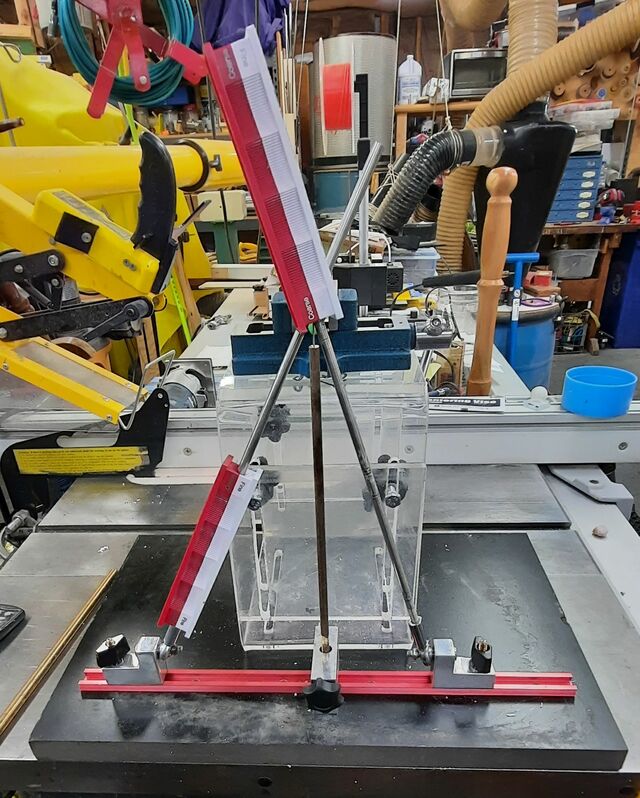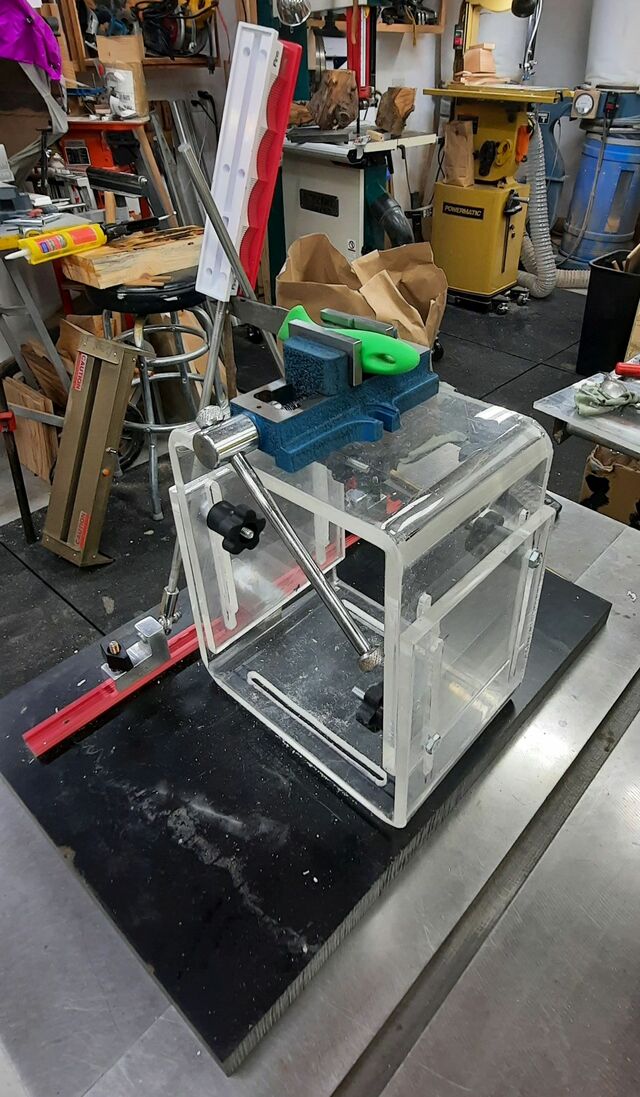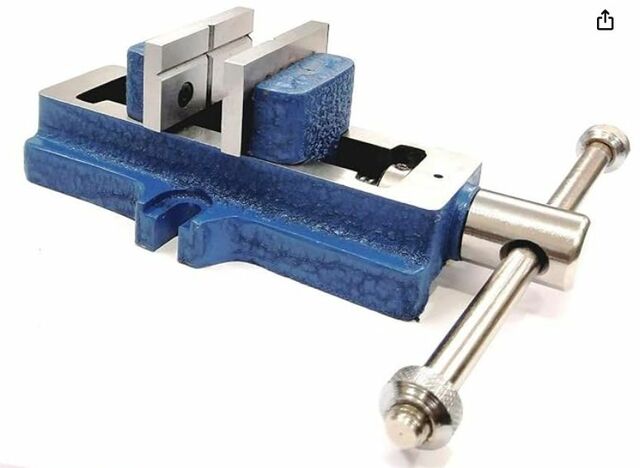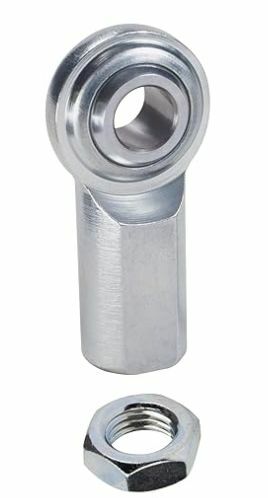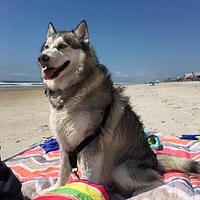Share your craft projects
Make new craft buddies
Ask craft questions
Blog your craft journey
Kelly
808 posts
and
17 followers
in almost 12 years
in almost 12 years
SOMETHING MORE THAN MERE WICKEDNESS THIS WAY MAY COME
KNIFE SHARPENING:
Tired of fighting for sharp edges on my knives, I, back around 2018, bought an Edge Pro knife [EP] sharpener.
The EP made a night and day difference in my knife (pocket, kitchen, hunting,) edges.
When free hand sharpening, all it takes is, getting near where you need to be, then tipping the blade a degree or two off your target and you are back three steps, because you altered the degree of approach. The EP helped me get past that problem.
About a year in to using the EP, I was talking with my wife and the conversation turned to that something we thought something seemed off with the potatoes. The reasoning was, the knives all but fell through them.
Both of us had been raised with the standard "rock back and forth with all your weight on it to cut it" kitchen knives. Yeah, sharpening skills were iffy in our house. And tossing our knives in the drawer with all the rest of the iron utensils didn’t seem to improve things.
In the end, we figured out the EP sharpened knives actually performed better than the dull, nicked edged knives we’d pulled out of a drawer in past times.
Now we won't settle for less than sharp, even with the cheap knives we yet have on the knife rack.
Enjoying better edges on knives can bring the same problem woodworkers, metalworkers and others come up against: "If that new tool made my work so much easier or quicker, what else am I missing?" It did, and I asked myself this question, as I fell down the tool rabbit hole.
To the aforementioned end, I have, for some time been enamored with the Wicked Edge [WE] sharpeners. This in spite of its many drawbacks research revealed. Things like:
(1) Having to buy extra, very expensive parts to sharpen knives at the sharper angles at which the Edge Pro wouldn't flinch.
(2) There the near or over $100.00 cost of each stone set.
(3) The up to $1,00.00 to $1,500.00 for the factory units.
(4) The complaints on that one side of the blade clamp is stationary, so clamping changes, if only minutely, the angle of sharpening between the two sides.
What I do like about the WE is, not having to flip the knife, not having to switch hands, having all settings stay stable, and the good looks of a FAIRLY well crafted tool.
Mindful of the CON’s of the WE, I am experimenting with building my own sharpener, but with significantly different approaches to solve some or all of its problems.
The biggest change is, clamping the handle, instead of the blade, so the problem of the sharpening stone hitting the blade clamp doesn't even make it out the gate, when the angle of grinding is steep.
To the end of building my sharpening system, I am fortunate in that I have a lot of materials in store in my shop. Things like one inch thick composite, like would be found on a science lab table, T-track for jigs, jig knobs, 10-24 or 1/4-20 bolts for jigs, pieces of aluminum of varying thicknesses, metal rods salvaged from printers, and a lot of Plexi and other plastics, and a lot of various types of wood. All things that lend themselves to the building of my sharpening system.
The wood, composite scraps, or laminated plastics can be used to make my own sharpening stone mounts.
Once the center holes are drilled to allow blanks to slide up and down the sharpener rods, they can be tailored in thickness, according to the thickness of the stones, leather or other material mounted on them.
The heavy composite makes a very stable base. Granite from a fabrication shop’s scrap pile could be used too, but would be more complicated to attach parts to.
Plastics salvaged from LED monitors and grabbed from yard sales work well for a base for the knife handle clamp. They do need to be bent, which may be done with a standard Nichrome plastic heater, or heating the plastic in a stove.
I used two pieces (1/4" thickness), one just a bit narrower than the other, so I could raise and lower the clamp base.
T-track is commonly used for jigs in woodworking and is ideal for allowing the sharpening rods to be adjusted for the angle needed to sharpen a knife.
Scrap aluminum from a salvage yard cut to accommodate the sharpening rods and a T-bolt to lock it to a given position on the T-track is a must, but the heavy composite or laminated plastic might do well for the task too.
It’s or a suitable replacement is a must for the support rod too.
Two 1/4" rods threaded to fit the swivel s were compliments of printers torn apart for their rods and tubes.
A 1/4"-20 tap made quick work of setting the rods up to screw into the purchased swivels.
Somewhere along the line, I acquired several brass rods. Stainless or steel would work as well for the blade support.
Later, I may 3-D some cylinders that will slide down over the blade support rod. They would have different sized notches for blades of different thicknesses.
The notched blade support would be especially important for knives with flexible blades, like fillet knives.
What I didn’t have for this project was, the 1/4-20 swivels for the sharpening rods and a self centering vice for the blade clamp. An on-line order took care of that.
SIDE NOTE: I've been distracted with scraping and sanding a sorely neglected house and railing wrapping three sides of it, in anticipation of painting them, and had to deal with a major breakdown of a critical pieces of equipment, so I haven't tended the last couple things to get this rocking and rolling. That is. mounting the Plexi to the composite base via a couple jig knobs, so it can move nearer and away from the blade support rod, and mounting the vice to the Plexi vice base.
Tired of fighting for sharp edges on my knives, I, back around 2018, bought an Edge Pro knife [EP] sharpener.
The EP made a night and day difference in my knife (pocket, kitchen, hunting,) edges.
When free hand sharpening, all it takes is, getting near where you need to be, then tipping the blade a degree or two off your target and you are back three steps, because you altered the degree of approach. The EP helped me get past that problem.
About a year in to using the EP, I was talking with my wife and the conversation turned to that something we thought something seemed off with the potatoes. The reasoning was, the knives all but fell through them.
Both of us had been raised with the standard "rock back and forth with all your weight on it to cut it" kitchen knives. Yeah, sharpening skills were iffy in our house. And tossing our knives in the drawer with all the rest of the iron utensils didn’t seem to improve things.
In the end, we figured out the EP sharpened knives actually performed better than the dull, nicked edged knives we’d pulled out of a drawer in past times.
Now we won't settle for less than sharp, even with the cheap knives we yet have on the knife rack.
Enjoying better edges on knives can bring the same problem woodworkers, metalworkers and others come up against: "If that new tool made my work so much easier or quicker, what else am I missing?" It did, and I asked myself this question, as I fell down the tool rabbit hole.
To the aforementioned end, I have, for some time been enamored with the Wicked Edge [WE] sharpeners. This in spite of its many drawbacks research revealed. Things like:
(1) Having to buy extra, very expensive parts to sharpen knives at the sharper angles at which the Edge Pro wouldn't flinch.
(2) There the near or over $100.00 cost of each stone set.
(3) The up to $1,00.00 to $1,500.00 for the factory units.
(4) The complaints on that one side of the blade clamp is stationary, so clamping changes, if only minutely, the angle of sharpening between the two sides.
What I do like about the WE is, not having to flip the knife, not having to switch hands, having all settings stay stable, and the good looks of a FAIRLY well crafted tool.
Mindful of the CON’s of the WE, I am experimenting with building my own sharpener, but with significantly different approaches to solve some or all of its problems.
The biggest change is, clamping the handle, instead of the blade, so the problem of the sharpening stone hitting the blade clamp doesn't even make it out the gate, when the angle of grinding is steep.
To the end of building my sharpening system, I am fortunate in that I have a lot of materials in store in my shop. Things like one inch thick composite, like would be found on a science lab table, T-track for jigs, jig knobs, 10-24 or 1/4-20 bolts for jigs, pieces of aluminum of varying thicknesses, metal rods salvaged from printers, and a lot of Plexi and other plastics, and a lot of various types of wood. All things that lend themselves to the building of my sharpening system.
The wood, composite scraps, or laminated plastics can be used to make my own sharpening stone mounts.
Once the center holes are drilled to allow blanks to slide up and down the sharpener rods, they can be tailored in thickness, according to the thickness of the stones, leather or other material mounted on them.
The heavy composite makes a very stable base. Granite from a fabrication shop’s scrap pile could be used too, but would be more complicated to attach parts to.
Plastics salvaged from LED monitors and grabbed from yard sales work well for a base for the knife handle clamp. They do need to be bent, which may be done with a standard Nichrome plastic heater, or heating the plastic in a stove.
I used two pieces (1/4" thickness), one just a bit narrower than the other, so I could raise and lower the clamp base.
T-track is commonly used for jigs in woodworking and is ideal for allowing the sharpening rods to be adjusted for the angle needed to sharpen a knife.
Scrap aluminum from a salvage yard cut to accommodate the sharpening rods and a T-bolt to lock it to a given position on the T-track is a must, but the heavy composite or laminated plastic might do well for the task too.
It’s or a suitable replacement is a must for the support rod too.
Two 1/4" rods threaded to fit the swivel s were compliments of printers torn apart for their rods and tubes.
A 1/4"-20 tap made quick work of setting the rods up to screw into the purchased swivels.
Somewhere along the line, I acquired several brass rods. Stainless or steel would work as well for the blade support.
Later, I may 3-D some cylinders that will slide down over the blade support rod. They would have different sized notches for blades of different thicknesses.
The notched blade support would be especially important for knives with flexible blades, like fillet knives.
What I didn’t have for this project was, the 1/4-20 swivels for the sharpening rods and a self centering vice for the blade clamp. An on-line order took care of that.
SIDE NOTE: I've been distracted with scraping and sanding a sorely neglected house and railing wrapping three sides of it, in anticipation of painting them, and had to deal with a major breakdown of a critical pieces of equipment, so I haven't tended the last couple things to get this rocking and rolling. That is. mounting the Plexi to the composite base via a couple jig knobs, so it can move nearer and away from the blade support rod, and mounting the vice to the Plexi vice base.
10 Replies
Thanks for the write up. Well done!
Ryan/// ~sigh~ I blew up another bowl. Moke told me "I made the inside bigger than the outside".
Now that shows dedication to getting the edge!
Thanks Ryan and Splinter.
Elsewhere, all the comments are about this being too much, they're able to do it freehand, their sand belt does it in a fraction the time, and so on.
The irony is, many making such comments beefed up or spruced up up their car, if not outright restored a classic, or they built a beautiful piece of woodwork, when an OSB box would function the same. In the end, it's almost comical that they believe THEIR choices, in what they do, make more sense. and it was so important they point out what is wrong with something they, really knew little or nothing anything about.
Then there is that no one I know and who owns fine steel (e.g., $200.00 or more knife) would let their knife anywhere near a grinder or sand belt to risk the temper. I have a four wheel I can vary from zero to 2.400 RPM, and it only gets to profile my lathe knives. My 1/42 sander is only for general work and touch up on the lathe knives. Maybe a mower blade.
As to time, ONCE you get the apex angle you were shooting for, my two wheel buffer (jeweler's rouge and chromium oxide) takes only a couple passes to bring, for example, my SV 110 blade back to good (push paper cuts) for another several weeks of cutting cardboard and such.
Even if I went back to the sharpener, it would be done in under five minutes, barring major damage requiring toothier stones and working up.
A little black marker on the blade and a super fine stone (all the stones are the same dimensions, so there is no shift in angle swapping them) tells me if I'm set to repeat (when it wears off fully and evenly), before jumping to the actual stone.
Anyway, there were times I thought I had sharp knives, but my expensive jigs proved I was wrong and there was better awaiting.
Elsewhere, all the comments are about this being too much, they're able to do it freehand, their sand belt does it in a fraction the time, and so on.
The irony is, many making such comments beefed up or spruced up up their car, if not outright restored a classic, or they built a beautiful piece of woodwork, when an OSB box would function the same. In the end, it's almost comical that they believe THEIR choices, in what they do, make more sense. and it was so important they point out what is wrong with something they, really knew little or nothing anything about.
Then there is that no one I know and who owns fine steel (e.g., $200.00 or more knife) would let their knife anywhere near a grinder or sand belt to risk the temper. I have a four wheel I can vary from zero to 2.400 RPM, and it only gets to profile my lathe knives. My 1/42 sander is only for general work and touch up on the lathe knives. Maybe a mower blade.
As to time, ONCE you get the apex angle you were shooting for, my two wheel buffer (jeweler's rouge and chromium oxide) takes only a couple passes to bring, for example, my SV 110 blade back to good (push paper cuts) for another several weeks of cutting cardboard and such.
Even if I went back to the sharpener, it would be done in under five minutes, barring major damage requiring toothier stones and working up.
A little black marker on the blade and a super fine stone (all the stones are the same dimensions, so there is no shift in angle swapping them) tells me if I'm set to repeat (when it wears off fully and evenly), before jumping to the actual stone.
Anyway, there were times I thought I had sharp knives, but my expensive jigs proved I was wrong and there was better awaiting.
I don't spend enough time on my knives. I'd never use a powered sharpener, but I do have a few devices (Lansky, etc) that I'll use when something is really hurting. Shop tools are easy as usually there are only straight edges. Knives really take a skill set that is a level up. If I used knives for more than opening boxes or chopping up some taters, I'd certainly invest in learning the skills.
Yep.
I've been on sites in which the click group mocks anyone who can't do precision freehand. In spite of my challenges, none are willing to prove their amazing muscle memory can sharpen, to perfection:
(1) My draw knives
(2) My chisels with various angles
(3) My kitchen knives, with various angles
(4) My cleavers
(5) My axes
(6) My lawn mower blades
(7) My lathe knives with various angles
(8) My hunting knives
(9) My various every day carry pocket knives with different steels (e.g., high carbon, SV 30, SV110. . . .)
(10) My carving knives
(11) My froe
(12) My mini from (doll house shakes)
(13) My carving chisels with various angles
(14) . . . .
Being able to get into the ballpark sharpening a hunting or pocket knife is great, but it takes time to develop the skill. Who is to say the guy who didn't hone that skill and, instead, honed other valuable skills, was the less for it?
As people more learned and expert than me said, the right edge is about degrees and changing even a few degrees can change the quality of the edge. For one reason, a well defined edge will last longer, whether because it was the right angle for the work and the steel being used, because of how often it will be touched up, or because the edge was better tended to after arrived at.
In the end, we can get the job done, but a guide can insure the job repeats. That is why I bought a Wolverine system for my four wheel grinder and its CBN wheels, a sharpening guide for my chisels and so on.
I've been on sites in which the click group mocks anyone who can't do precision freehand. In spite of my challenges, none are willing to prove their amazing muscle memory can sharpen, to perfection:
(1) My draw knives
(2) My chisels with various angles
(3) My kitchen knives, with various angles
(4) My cleavers
(5) My axes
(6) My lawn mower blades
(7) My lathe knives with various angles
(8) My hunting knives
(9) My various every day carry pocket knives with different steels (e.g., high carbon, SV 30, SV110. . . .)
(10) My carving knives
(11) My froe
(12) My mini from (doll house shakes)
(13) My carving chisels with various angles
(14) . . . .
Being able to get into the ballpark sharpening a hunting or pocket knife is great, but it takes time to develop the skill. Who is to say the guy who didn't hone that skill and, instead, honed other valuable skills, was the less for it?
As people more learned and expert than me said, the right edge is about degrees and changing even a few degrees can change the quality of the edge. For one reason, a well defined edge will last longer, whether because it was the right angle for the work and the steel being used, because of how often it will be touched up, or because the edge was better tended to after arrived at.
In the end, we can get the job done, but a guide can insure the job repeats. That is why I bought a Wolverine system for my four wheel grinder and its CBN wheels, a sharpening guide for my chisels and so on.
I used Worksharp products to sharpen my knives. I can't free hand sharpen anything. If it's a knife or a #8 iron. The Worksharp gets them sharp but they could be better.
well hand sharpening will never replace a precision method. no human hand can out do a machine set at a precise angle. i wont even try. thats why i have a lot of machines and jigs that will.
working with my hands is a joy,it gives me a sense of fulfillment,somthing so many seek and so few find.-SAM MALOOF.
The Worksharps have fascinated me for some time because of the rave reviews they get for what the work well with. As have the Tormex. One could, easily, have a whole wall of sharpening equipment (buffers, grinders, sanders, Delta sharpener, Makita sharpener, Tormex, Worksharp. . . .
The worksharp does do a excellent job at sharpening chisels and plane irons.
ADDITION: I bought a couple of the WE diamond stones so I could copy the standard for making my own using hardwood and cheap stones that fit my Edge Pro.
THEN Wicked Edge had a sale on a new line of sharpeners, which came with two sets of stones I didn't have. I was, temporarily, rich that month, so bought one. Then I waited the couple months for delivery on the new line.
The WE came. I mounted it on another piece of the heavy composite I had. Minutes later, I am very pleased with the $200.00 investment. It's quicker than the Edge Pro to set up for kitchen knives. They were wicked sharp in minutes.
With the new stones in hand, I put the commercially built WE to the side and pulled out my WE inspired version built to save a buck and to solve the aforementioned WE problems. I was WAY tickled at how quick it went. Even quicker than using the commercial unit.
I blew through three kitchen knives, walked them over to the buffer, polished the 1,000 grit edges and they were pushing through paper.
If worse comes to worse, my buddy will get a nice Christmas gift, since he's caught the knife bug. He'll just have to buy his own stones.
Meanwhile, I need to detail out my sharpener. Things like adding stone storage, mounting it on the office chair base I kept from the last replacement. Maybe, adding a drawer. . . .
THEN Wicked Edge had a sale on a new line of sharpeners, which came with two sets of stones I didn't have. I was, temporarily, rich that month, so bought one. Then I waited the couple months for delivery on the new line.
The WE came. I mounted it on another piece of the heavy composite I had. Minutes later, I am very pleased with the $200.00 investment. It's quicker than the Edge Pro to set up for kitchen knives. They were wicked sharp in minutes.
With the new stones in hand, I put the commercially built WE to the side and pulled out my WE inspired version built to save a buck and to solve the aforementioned WE problems. I was WAY tickled at how quick it went. Even quicker than using the commercial unit.
I blew through three kitchen knives, walked them over to the buffer, polished the 1,000 grit edges and they were pushing through paper.
If worse comes to worse, my buddy will get a nice Christmas gift, since he's caught the knife bug. He'll just have to buy his own stones.
Meanwhile, I need to detail out my sharpener. Things like adding stone storage, mounting it on the office chair base I kept from the last replacement. Maybe, adding a drawer. . . .









